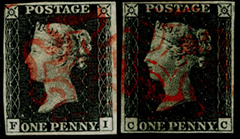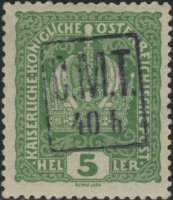 First Issues Collectors Club
of stamps and philatelic material
First Issues Collectors Club
of stamps and philatelic material
Home - Catalog - Categories - Index - Journal - Exhibits - Auctions - Forgeries - Join
 First Issues Collectors Club
of stamps and philatelic material
First Issues Collectors Club
of stamps and philatelic material
Home - Catalog - Categories - Index - Journal - Exhibits - Auctions - Forgeries - Join
| first issues > countries > western ukraine, romanian occupation |
| Rusian entities | 34b |
 |
||
| Romanian occupation of Western Ukraine, Scott #N3 | xxx |
Perforated 12½, no watermark, typography.
| Description | # issued | # remaining | Scott | SG | Mi | Y&T |
|---|---|---|---|---|---|---|
| On stamps of Austria 1916 - 1918 issues | ||||||
40 heller on 5 heller light green |
8 | 0 | N3 | 3 | ||
1 krone 20 heller on 50 heller dark green |
2,600 | 130 | N10 | 21 | ||
1 krone 20 heller on 60 heller deep blue |
40 | 0 | N11 | 22 | ||
1 krone 20 heller on 1 krone carmine, yellow paper |
820 | 0 | N14 | 31 | ||
On stamps of Austria 1917 - 1918 issues. |
||||||
60 heller on 15 heller dull red |
4,500 | 12 | N15 | |||
60 heller on 20 heller deep green |
16,000 | 5,190 | N16 | |||
60 heller on 25 heller blue |
3,200 | 0 | N17 | |||
60 heller on 30 heller dull violet |
2,600 | 0 | N18 | |||
Postage due stamps. |
||||||
On postage due stamps of Austria 1910 issues. |
||||||
1 krone 20 heller on 25 heller carmine |
118 | 30 | Not listed | |||
On postage due stamps of Austria 1916 issues. |
||||||
40 heller on 5 heller rose red |
800 | 41 | NJ1 | |||
1 krone 20 heller on 25 heller rose red |
120 | 0 | NJ5 | |||
1 krone 20 heller on 30 heller rose red |
17 | 0 | NJ6 | |||
On postage due stamps of Austria 1917 issues. |
||||||
1 krone 20 heller on 50 heller on 42 heller chocolate |
15 | 2 | NJ13 | |||
All issue quantities are approximate.
The missing catalog numbers are not assigned by Scott.
One thousand 10 heller postal cards, both internal and external, were also surcharged with a 40 heller value.
Fortunately for the first issues collector all these stamps are first issues since they were all issued at the same time.
Most of the information here is due to Mr. Ivan Cherniavsky, a president of the court in the town of Kolomyia and Director for Judicial Affairs during the Romanian occupation of the Pokuttia region. He was an eye witness who counted and wrote down numbers and facts as they happened. He was also a philatelist.
The date of issue given here is calculated as follows. On the 12th of June the postal service was re-opened by the occupation authorities. However, the only stamps available were Romanian 5 and 10 bani stamps. On the afternoon of the 14th all the surcharged stamps were received in Kolomyia from Chernivtsi. They were immediately distributed to a few other post offices: Deliatyn, Horodenka, Lanchyn and Sniatyn. Therefore, the stamps would have been available for sale no earlier than on the 14th of June, 1919 and possibly only in Kolomyia. The post offices at Pechenizhyn and Zabolotiv later asked for and got 360 stamps and Obertyn got 240. These quantities should be subtracted from the total given to Kolomyia but the specific distribution is not known. These are the only eight cities which received the stamps. It has not been confirmed if the stamps were used in Deliatyn and Lachyn.
The occupation ended on the 20th of August, 1919. All post offices were to return the remainder of their stamps to Kolomyia. On August 21, 1919 the Romanian forces left and the Polish army took over all of Pokuttia.
Only eight copies of #N3 was produced according to Mr. Cherniavsky. Some experts question this number, saying that the real number is far greater.
Eight copies of #N16 exist with inverted surcharge, again according to Mr. Cherniavsky. He also states that "several dozen stamps on the 20 heller sheets had a double surcharge". These are the only varieties known to exist. Most of these stamps were put into normal use.
The Romanian army issued these stamps during their occupation of the Pokuttia region of Western Ukraine. A certain major Turbatu was in charge of the overprinting and organization of the postal service. The overprint C.M.T. stand for "Comandamentul Militar Teritorial" or "The Territorial Military Command" according to Mr. Cherniavsky, others take it to mean "Campanie Militar Timbru" which translates to "Military Campaign Stamp".
Forgeries abound as is often the case with overprints. These forgeries may be very difficult to detect since the overprints were done with the original dies. It is strongly advised that you get a certificate of authenticity on these stamps. Any color surcharge other than dark blue black and surcharges on any other stamps are either proofs or bogus. Blue or red ink is thought to have been used for proofs, but there is little or no evidence to support this theory. It is a known fact that stamps were unofficially overprinted after the Romanian occupation ended. The dies were subsequentally destroyed.
Many of the names used here are known with different spellings and in different languages. A few examples are provided to help you in your search for more information.
| FI ref: 494 | Page credit: JA |
| Page created 19 Feb 2014 | Page updated 2 Jun 2016 |